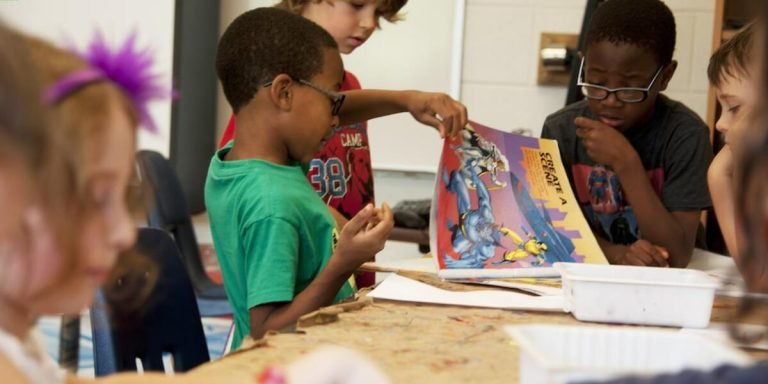What Grade is a 4 Year Old In? A Detailed Exploration for Parents and Educators
Understanding the grade level of a child is an essential step in navigating their educational journey. The question, “what grade is a 4 year old in?” may seem straightforward at first glance, but there are multiple factors that come into play when making this determination. Factors such as your nation’s education system guidelines and the specific development stage of the child can significantly influence this.
This post provides a detailed exploration on this topic for both parents and educators who seek clarity about school grading systems for youngsters. Our aim is to provide nuanced insights specifically around early childhood education with particular emphasis on elementary school settings to help you make well-informed decisions concerning four-year-olds’ educational placement.
Did you know?
Did you know that in several European countries like Finland and Estonia, formal education doesn’t start until the age of 7? Until then, play-based learning is heavily emphasized for all children including four-year-olds.
Understanding the Educational Journey: Placement of 4-Year-Olds
Pre-kindergarten (also known as preschool or nursery school) generally embraces children aged three to five years old and serves as an intermediary stage between home-based learning experiences and kindergarten’s more structured environment. This placement offers the prime opportunity for youngsters to expand upon their socialization skills while introducing them gently into academia.
A child turning four during a school year may also find themselves navigating through Transitional Kindergarten depending on local district’s offerings—a relatively recent addition across some regions aiming at aiding those who just miss out on meeting age criteria for regular kindergarten enrollment due to birthdays falling later within the academic calendar year.
It’s essential to remember though that every child develops at his or her unique pace; thus ‘standard’ milestones should always remain flexible guidelines rather than rigid expectations when determining suitable class placements for young learners like our curious four-year-olds!
Navigating Pre-K: The Starting Point for Four-Year-Olds
Understanding a child’s educational journey can be quite challenging, especially when it comes to the placement of 4-year-olds. Often, parents and educators ask us “what grade is a 4 year old in?” The simple answer lies in Pre-Kindergarten (Pre-K) classes.
Navigating through this phase is critical as Pre-K forms the foundational layer for a robust elementary school education. It aims at promoting cognitive development along with social-emotional growth while preparing them for structured learning environments ahead.
Children around four years old are typically ready for engaging activities that stimulate natural curiosity and enthusiasm about discovering their world. In Pre-K classrooms across America today, you’ll find children exploring colors and shapes; getting introduced to basic counting principles – all key skills shaping young minds’ understanding of more complex subjects they will encounter down the line.
Kindergarten Readiness: Assessing Your Child’s Developmental Milestones
Kindergarten readiness is a critical aspect of elementary school education. Numerous parents ponder the big question, “What grade is a 4 year old in?” By understanding their child’s developmental milestones, they can assess if their youngster is ready for kindergarten or whether another year of preschool would be beneficial.
Identifying your youngster’s cognitive abilities forms an essential part of this evaluation process. A four-year-old who showcases problem-solving skills, understands basic concepts such as numbers and shapes, demonstrates early literacy by identifying letters in alphabets and possesses keen observational skills stands at a better position to explore the kindergartner journey effectively.
Social-emotional development also holds significant importance when deciding what grade your 4-year-old should be in. Children thriving on sharing games with others, expressing needs verbally without tantrums and displaying empathy towards peers indicate kindergarten readiness emotionally.
An additional measure includes observing physical developments like fine motor control expressed through actions like holding crayons correctly or using scissors giving hints about preparedness for higher-level tasks encountered within Kindergarten settings.
Lastly comes language proficiency – children who speak understandably most times and exhibit vocabulary growth portray strong linguistic competency which assures smooth transition into more formal learning environments such as Kindergartens; making them seemingly apt candidates to navigate academic life successfully therein.
Educational Building Blocks for Young Learners
Understanding the grade level of a 4-year-old is an important facet when laying down the educational building blocks for young learners. In most parts of the world, including North America and Europe, children at this age are typically not in any formal “grade”. However, they are usually enrolled in pre-kindergarten or preschool programs aimed to get them academically ready.
These structures have been put into place bearing in mind their cognitive development stage and gradually prep them up for more structured learning environments.
Preschool focuses on fostering social skills and provides early literacy instruction to ensure a smooth transition into kindergarten. In 2023, there’s an increased focus on setting strong foundations in these formative years because of their crucial impact on later elementary school education. Older kids naturally understand academics over time with maturation and exposure during these stages. However, it’s becoming increasingly important for parents to prepare beforehand to ensure their children are ready mentally and emotionally moving forward.
Core Curriculum for Preschoolers: What to Expect at Age 4
Typically, four-year-olds are either finishing up preschool or beginning pre-kindergarten (pre-K) – this varies between school districts and individual child development rates.
In terms of content learning at this level concentrates on early literacy skills like recognizing letters, numbers, shapes and colors. They’ll start understanding the basic concepts of math such as counting objects while also gaining exposure to science through real-life observations.
A significant part of their day will involve exploring arts; drawing shapes which develop fine motor skills required for writing later on. Additionally music plays an integral role bringing rhythm into their lives that help them understand patterns – key cognitive building blocks!
While focusing on academic abilities it’s crucial not to overlook developing emotional intelligence within children especially empathy aspect & handling emotions – vital life skillset.
Social and Emotional Growth in Early Childhood Education
In this section, we delve into a key component of early childhood education – Social and Emotional Growth. As parents or educators, understanding the social-emotional development journey is critical in providing healthy educational building blocks for young learners.
The stage between three to six years old marks rapid developmental changes in children. Often, parents ponder “what grade is a 4 year old in”, but it’s vital to know that their learning goes beyond grades at such an age. The focus should be not just on cognitive skills but also on fostering strong social and emotional foundations.
Firstly, let’s understand what constitutes as ‘Social-Emotional growth.’ It refers to how children start grasping their own feelings and those around them; develop empathy; manage emotions constructively; establish positive relationships with peers and adults alike while coping effectively with challenging situations using appropriate responses.
Children spend most hours of the day interacting within school environs which significantly influence their socio-emotional progression alongside academics during these formative years.
1) In terms of addressing negative behaviors like tantrums or rebellions among four-year-olds who attend pre-K classes (typically where they belong), teachers can utilize constructive strategies like emotive storytelling sessions or role plays that help embed valuable lessons subtly yet assuredly about managing difficult scenarios empathetically.
Nurturing Academic Foundations in Early Years
Understanding the appropriate academic phase for a child is an essential factor in nurturing their foundations. When it comes to being four years old, many parents and educators often question what grade such a youngster belongs in. In most educational systems around the globe, including America’s elementary school education system as of 2023, children at this age are usually enrolled in pre-kindergarten.
Pre-kindergarten or ‘pre-K’ is more than just another year of toddlerhood; it serves as a vital step leading towards formal schooling. It lays down strong groundwork that prepares them mentally and emotionally for kindergarten where structured learning begins earnestly.
The objective during these early years isn’t merely understanding alphabets or counting numbers but also instilling essential life skills like following instructions, interacting with peers and developing motor abilities through play-based activities. In essence, pre-kindergarten provides our young ones with confidence building blocks they need before stepping into formalized education.
While some may think that enrolling their 4-year-old into kindergarten makes sense due to advanced capabilities observed at home settings , experts suggest waiting until children meet the traditional enrolment age criteria which typically falls around five-plus years of age. This allows youngsters adequate time to grasp important socio-emotional lessons within peer environments fostering better overall growth trajectory while reducing coping-related stress later on when curriculums become progressively intense in higher grades.
Interactive Learning Strategies for the Pre-K Classroom
Understanding the academic levels of children in their early years can often be a tricky prospect for parents and educators. Many grapple with questions like “what grade is a 4 year old in?” or “how should learning proceed at this stage?”. As we navigate through this part of the post, let’s explore some interactive learning strategies that could help foster strong educational foundations.
The pre-kindergarten setting affords an ideal environment to introduce young learners to important academic concepts while keeping engagement high. Children around four years are typically enrolled into Pre-K programs where they begin their formal education journey.
One potent strategy could be integrating playful elements into lessons – kids learn best when they’re having fun! This approach doesn’t just make content enjoyable but also enhances memory retention by associating positivity with academics. Games involving simple arithmetic operations or alphabet recognition can greatly bolster cognitive development among students.
Another effective tool within your arsenal might involve leveraging technology as a means to aid instruction- it’s 2023 after all! There are numerous apps specifically designed for pre-schoolers, providing animated stories and games which reinforce basic mathematics/linguistic skills amicably.
Moreover, remember that peer-to-peer interaction plays an integral role during these formative years; hence group activities must not go neglected. Assigning team projects encourages communication amongst pupils fostering teamwork abilities besides enhancing social-emotional growth substantially- key cornerstones as one progresses forward academically!
Importance of Play-Based Learning at the Preschool Level
A child’s early years are crucial in laying the foundation for lifelong learning and success. One important aspect during this stage is understanding what grade a 4 year old would typically be in. In most regions, four-year-old children belong to preschool or pre-kindergarten classes.
Preschool education plays an incredibly vital role that goes beyond academic growth – it introduces children to play-based learning methods which help nurture their cognitive, emotional and social capabilities remarkably well.
In a world where educational landscapes continuously evolve, educators have recognized the significance of not just focusing on competitiveness but also fostering holistic development right from the start — hence emphasizing more on play-based learning at preschool level.
Playing seems simple yet it encompasses myriad developmental areas making it ideal for establishing solid academic foundations among youngsters. Toys become tools aiding learners explore complex concepts like counting blocks facilitating discussions about shapes and quantities – forming roots of mathematical skills later employed extensively during elementary school education.
Through playing kids further develop language abilities as they engage with peers sharing toys or taking turns down swings; promoting conversations while developing vocabulary plus enhancing listening comprehension skills too.
When 4-year-olds immerse themselves into make-believe scenarios such as pretending being astronauts flying around space – creativity gets stimulated immensely offering lateral thinking ability necessary throughout life.
Conclusion
In conclusion, solving the curiosity of “what grade is a 4 year old in” isn’t as challenging or confusing anymore. We have traversed through every necessary detail to make this process simpler for parents and educators alike. Every child’s journey is unique but knowing their educational placement can significantly help guide them on that path.
As you continue to unravel more about your young one’s academic odyssey, we invite you to explore our repository packed with informative articles around childhood education. From providing an understanding of developmental milestones, learning techniques or managing those tricky tantrums – we’re here offering unwavering support in shaping inspiring minds of tomorrow. Let us navigate this wonderful journey together – because empowering caregivers equals empowered children!







